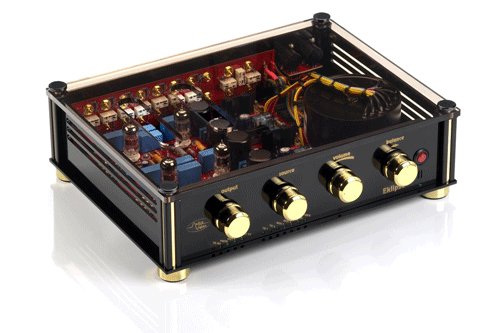Audio Valve Eklipse Preamplifier
| Audio Valve Eklipse Preamplifier |
| How far can a little tube magic take you? |
|
|
|
September 2008 |

An instant non-fatal attraction
It was around the end of Fall 2007 and my time spent with the GamuT M250 mono-amps had just come to an end. I’d driven up to Libertyville, Illinois to meet with the local GamuT dealer, Mike Kay of the Audio Archon, to drop off the amplifiers. We finally got the amps back into his listening room when I noticed that sitting on an isolation platform, was a preamplifier that I hadn’t recalled seeing in his system the last time I was there. I asked Mike the name of that preamplifier and he said it was the Audio Valve Eklipse preamp from Germany. For the rest of that afternoon I could not take my eyes off of this preamp. It looked to be well made, had an acrylic top plate, and lo and behold, the beautiful glow of vacuum tubes. I asked him if he would make arrangements for me to get one in for review and a few months later, he did just that.
Being able to see an Eklipse
The Audio Valve Eklipse arrived nicely packed in a wooden crate. The Eklipse, as mentioned above, is a vacuum tube based preamp that uses four 12AU7 tubes from Electro Harmonix. As is the practice with many high end preamps these days, Audio Valve pays a lot of attention to how their products will operate and look in the home. The first thing I noticed, aside from how attractive the unit looks, is how solid and well built it felt. Weighing in at around 44 lbs (no doubt helped by its steel chassis), the Eklipse is among the heaviest and most solidly built preamp that I have had the pleasure of reviewing. The look and feel of the Eklipse is confidence-inspiring. The control knobs and the connectors all had a solid feel to them with no wiggle or looseness. The attractiveness of the inside of the preamplifier is facilitated by a clear acrylic top that has two grooved out notches located on the left side, placed over the tubes for increased ventilation. Audio Valve offers the Eklipse faceplate in two colors, black with gold lettering and silver with black lettering. With the eye catching, large custom made brass anodized knobs dominating the faceplate, either the silver or the black will enhance the look of your system.
In terms of those knobs, they are from left to right, ‘Output’, for selecting which of the preamp’s outputs paths will send the signal to the amplifier, ‘Input’, Volume’ and ‘Balance’. The rear of the preamp has seven line inputs, with facilities for tape in and out, and three sets of outputs, one using balanced connectors and the other two, single ended. Also clearly noticeable in the Eklipse, and aiding to its eye-catching interior is a large, 160-watt toroidal transformer sitting on its right side.
According to Audio Valve’s website, their PC board is a “… special two sided, 2 oz. pure copper panel known as a FR4, a military approved high-quality PC motherboard. Created with special software, the FR4’s design eliminates the need for point-to-point soldering. The signal and power lanes are separated by ground traces or block of grounds to minimize cross talk or noise.”
The Eklipse’ remote is functional but its button layout took me a little while to get used to. The build quality and look of the Eklipse are a portent of things to come from the listening experience.
How does it sound?
To borrow a phrase from Audio Valve’s website: “The EKLIPSE is a true class A line stage pre-amp, designed for the audiophiles who want pure analog with the highest quality sound available, without the price of one.” I would say this is largely true. Once you’ve gotten accustomed to the good looks of the Eklipse and go through the setup, and once you start to listen, you’ll hear exactly what they mean. The Eklipse is a very natural-sounding preamp. It rests slightly on the warm side of neutral, which you may come to expect from a tube preamp.
The midrange performance of this preamplifier was exceptional. Instruments are portrayed with their wide range of tonal colors and rich overtones, and vocalists sound realistic, portrayed with all the sweetness, warmth, and natural attributes you want to ascribe to vocalists. You can tell when singers are straining, sound nasally and congested, or have just rolled out of bed and decided to start singing. The Eklipse reveals all of these differences and hides nothing. Pianos also sounded sonorous, allowing you to easily tell the difference between the tonal decay of a Steinway and Bosendorfer.
High frequency performance was good. Cymbals, bells and triangle had good extension, while wind instruments, saxophones, horns and the like, sounded accurate. Bass performance, while having good weight and extension, was not anything to get excited about. I was having a nice experience with the Eklipse until I spoke with a friend of mine who I didn’t know owned an Eklipse. I knew he had a Sonic Frontiers preamp, but he never mentioned to me that he had purchased an Eklipse preamp. He told me (and I was later able to confirm) that the Electro Harmonix tubes that Audio Valve sends with the Eklipse, while very nice, don’t reveal what this preamplifier is capable of. He strongly urged me to get a hold of some new old stock (NOS) tubes, any NOS tubes that I had a flavor for, and listen to the Eklipse for an extended time. Though a bit skeptical, a few weeks later I decided to borrow a set of RCA ‘Clear Top’ tubes from the same friend, just to see if there was any merit to his claim. Suffice it to say, his recommendation was spot on. Suddenly, life with the Eklipse changed.
I was simply amazed at what a change in tubes could do to a preamp. It was in no way subtle and made me question, in the back of my mind, why Audio Valve would send their preamps out in the world with tubes that, to my ears, don’t get the best from their design. I can only assume that maybe it’s a cost issue.
The high frequencies that I felt were good, became very good. The midrange performance got even better. The bass performance took on a big improvement as well, as my speakers were now noticeably moving more air due to the more robust signal the amplifier was being fed. If I were to sum the change up in a word, it would be “exciting.” The music took on so much more life and energy that the experience became exciting. The performers could now convey their message and emotion in such a way that caused me to be drawn deeper into the music.
 One of my favorite vocal references is Jane Monheit’s In the Sun [N-CODED MUSIC 4234-2]. When I played this CD with the stock tubes in place, this disc sounded like a good recording, but there was no excitement to the music and I didn’t feel a connection. With the NOS tubes in place, I could have sworn she was in my room, and not only that, I could feel the songs as she was singing them. Somehow, I felt that I was involved with the music. That’s an example of the kind of differences I noticed when I went from stock to tubes to NOS tubes in this preamplifier. On Nels Cline’s CD The Inkling [Crypto-Gramophone], I had a similar experience. I have termed Nels’ playing as being “avant-garde” for guitar. With the stock tubes in place, Nels sounded like he was playing loud, or going through the “angry young man” syndrome as the music was diffuse, but I couldn’t figure out why. With the NOS tubes in place, I could tell he was playing with intensity and began to understand the confusing parts of the music. It was as though I now had someone there, in my head, telling me what the music was conveying.
One of my favorite vocal references is Jane Monheit’s In the Sun [N-CODED MUSIC 4234-2]. When I played this CD with the stock tubes in place, this disc sounded like a good recording, but there was no excitement to the music and I didn’t feel a connection. With the NOS tubes in place, I could have sworn she was in my room, and not only that, I could feel the songs as she was singing them. Somehow, I felt that I was involved with the music. That’s an example of the kind of differences I noticed when I went from stock to tubes to NOS tubes in this preamplifier. On Nels Cline’s CD The Inkling [Crypto-Gramophone], I had a similar experience. I have termed Nels’ playing as being “avant-garde” for guitar. With the stock tubes in place, Nels sounded like he was playing loud, or going through the “angry young man” syndrome as the music was diffuse, but I couldn’t figure out why. With the NOS tubes in place, I could tell he was playing with intensity and began to understand the confusing parts of the music. It was as though I now had someone there, in my head, telling me what the music was conveying.  Wynton Marsalis’ wonderful From the Plantation to Penitentiary [Blue Note] disc, for me, has to be one of the more emotionally charged works that he’s done. When I played it through the Eklipse with NOS tubes, I was stunned at how much more power and emotion that the vocal ensemble sang with and that Wynton played. Laurence Juber’s CD, Guitar Noir[AIX Records] sounded very nice with the stock tubes, but became one of the most enjoyable pieces of guitar music I’d heard with the NOS tubes in place. The plucking on the strings had more verve and energy, and the percussion had greater transient speed and snap.
Wynton Marsalis’ wonderful From the Plantation to Penitentiary [Blue Note] disc, for me, has to be one of the more emotionally charged works that he’s done. When I played it through the Eklipse with NOS tubes, I was stunned at how much more power and emotion that the vocal ensemble sang with and that Wynton played. Laurence Juber’s CD, Guitar Noir[AIX Records] sounded very nice with the stock tubes, but became one of the most enjoyable pieces of guitar music I’d heard with the NOS tubes in place. The plucking on the strings had more verve and energy, and the percussion had greater transient speed and snap.
Winding things up
My review of the Eklipse very easily could have been called “A Tale of Two Preamps.” The Eklipse with the stock Electro Harmonix tubes is, in my opinion, a good preamp. Nothing really wrong with its performance, but sonically nothing to really get excited about, save for its nice midrange performance.
During the time that I had the Eklipse in my system, I also had on hand my reference Klyne System 7 linestage, the Conrad-Johnson ACT2 Series II, the XLH XL-11XS, the ModWright 36.5 and the GamuT D3. The ACT2 was the class of the bunch with the Eklipse a step below it. But when I put the RCA Clear Top tubes in the Eklipse, it bested these competitors, inlcuding the CJ ACT2. I had a lot of listening sessions with friends over this period of time, and each reached the same conclusion.
Don’t get me wrong, I was in serious lust for the ACT2 and, up to that point, was prepared to call it the best preamp to ever grace my listening room. But the Eklipse eclipsed (pardon the pun) the ACT2’s performance, and at less than a third of the price to boot. The amount of realism and lifelike dynamics, and the ability to communicate the music was a step beyond what the other preamps on hand were doing.
This preamp is a “tube rollers” dream. Depending on what your sonic tastes are will determine which tubes you will want to use in your Eklipse. While you may like the sound of the Eklipse with the stock Harmonix tubes, in my humble opinion, NOS tubes like the RCA Clear Top take its performance to a higher level. Highly recommended!
![]()
![]()
Specifications
Concept: high class douple mono pre-amplifier
Output Level: 15 V max.
Power Bandwidth: 4 – 45.000 Hz.
Distortion: 0,1 % (1V)
Noise: 0.5 mV (Volume noise limiter)
Inputs: 7 Line In, & 1 Line Out, tape loop
Output Impedance: 300 Ohms
Power Consumption: 40 Watt
Line Voltage: 117 up to 240 VAC
Valve Line – Up: 4*6189
Spec.-Features: Stand By & Mute Function, remote control
Dimensions: (w-d-h) 420 X 320 X 130 mm
Weight Net: 20 kg
Sensitivity of each set of inputs:
CD1 – 17 dB – 20K
CD1 – 22 dB – 16K5
AU1 – 15 dB – 19K
AU2 – 20 dB – 15K
AU3 – 24 dB – 15K
TUN – 26 dB – 17K
TP – 26 dB – 17K
Audio Valve Eklipse Preamplifier: $4,799 – Black
$5,299 – Silver
Manufacturer
AudioValve
Auf dem Streken 7
D-32689 KALLETAL – GERMANY
Tel.: 0049 – (0) 5264 77 99
Fax: 0049 – (0) 5264 65 44 77
VAT.-ID. de195191420
WEEE-Reg.-no.: DE81178274
Email: export@audiovalve.info
Website: www.audiovalve.info
US Distributor:
Lombardi Sales,
Simi Valley, CA
Phone: (805) 444-6130
Fax: (805) 522-0989.
Web: www.rayofsound.com
![]()
Don’t forget to bookmark us! (CTRL-SHFT-D)
Stereo Times Masthead
Publisher/Founder
Clement Perry
Editor
Dave Thomas
Senior Editors
Frank Alles, Mike Girardi, Russell Lichter, Terry London, Moreno Mitchell, Paul Szabady, Bill Wells, Mike Wright, and Stephen Yan,
Current Contributors
David Abramson, Tim Barrall, Dave Allison, Ron Cook, Lewis Dardick, John Hoffman, Dan Secula, Don Shaulis, Greg Simmons, Eric Teh, Greg Voth, Richard Willie, Ed Van Winkle, Rob Dockery, Richard Doran, and Daveed Turek
Site Management Clement Perry
Ad Designer: Martin Perry





Be the first to comment on: Audio Valve Eklipse Preamplifier